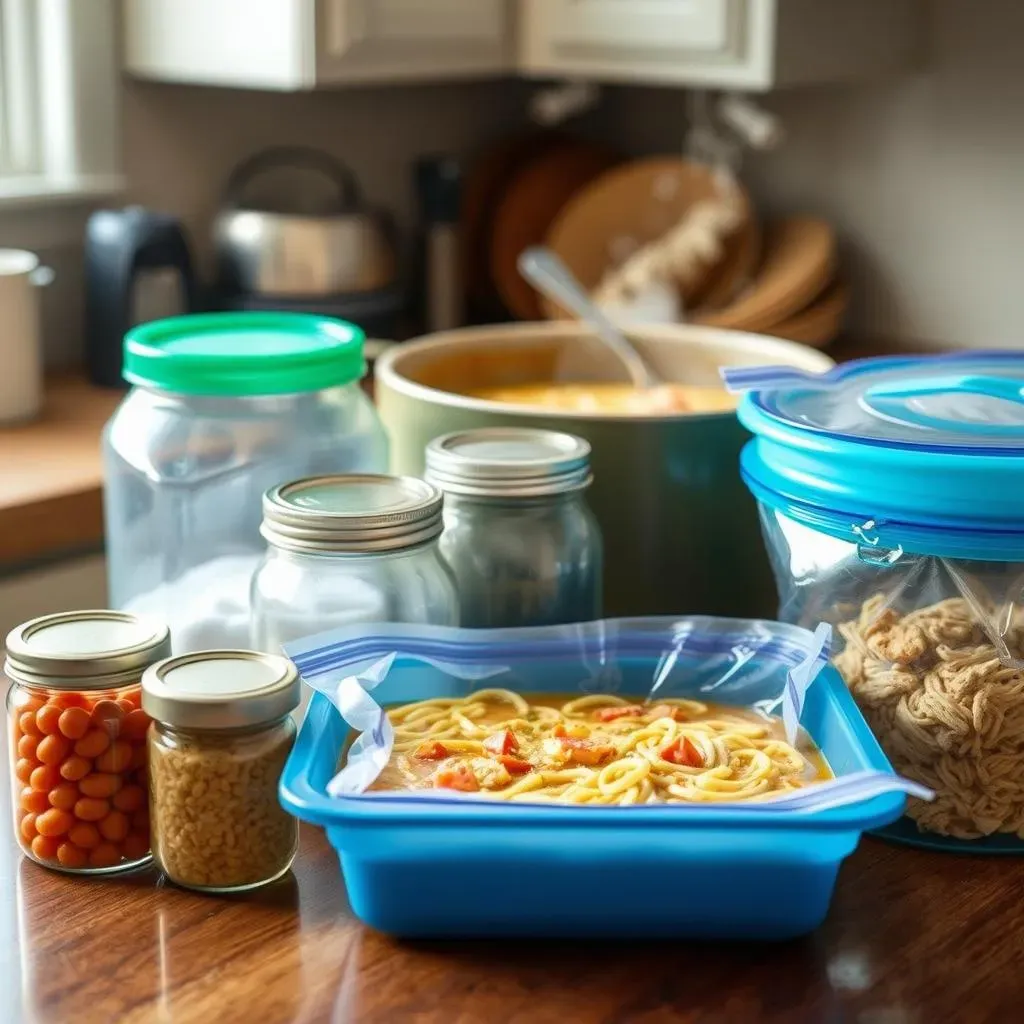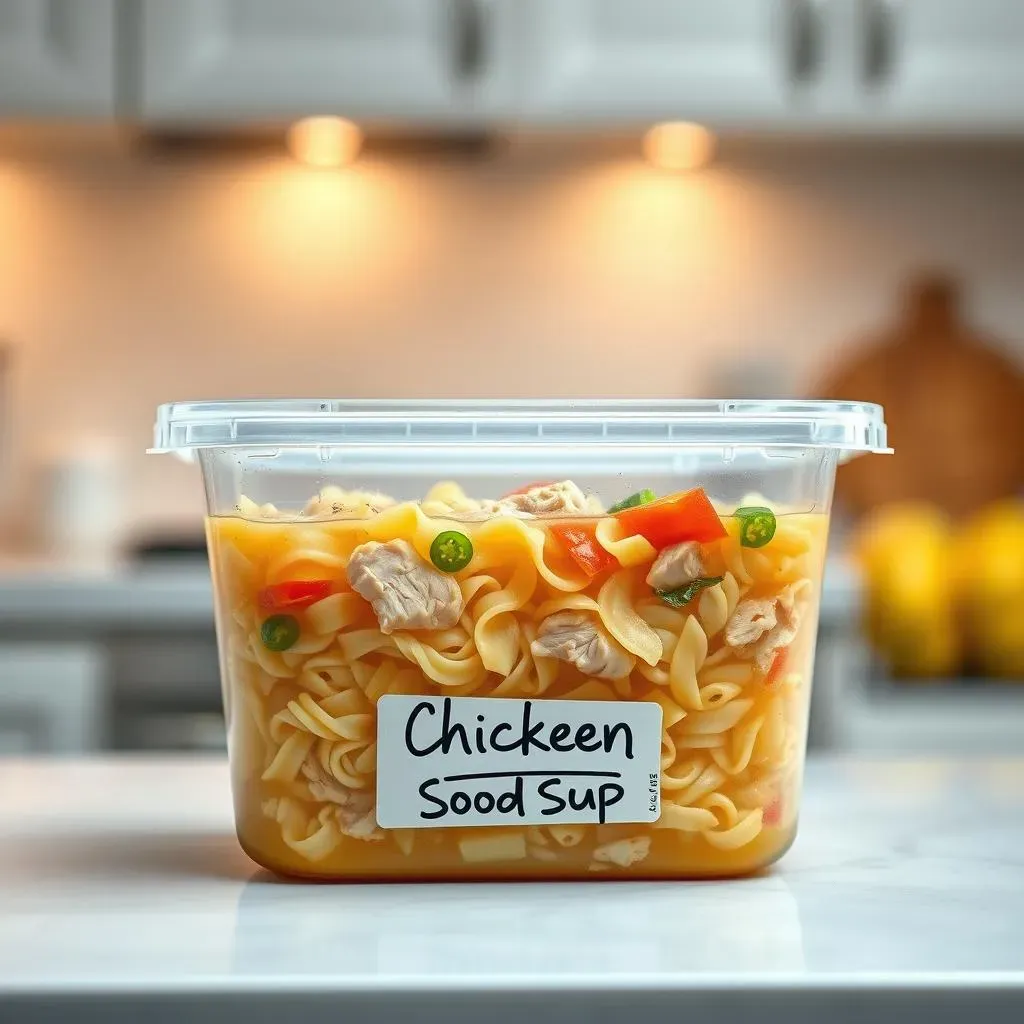Table of Contents
Picture this: you've just made a huge pot of comforting chicken noodle soup, perfect for a chilly evening. But, surprise! There's way too much. Now, you're wondering, "can chicken noodle soup be frozen?" The good news is, yes, absolutely! Freezing your leftover soup is a fantastic way to save time and reduce food waste, ensuring you have a quick and delicious meal ready whenever you need it. In this article, we’ll explore the ins and outs of freezing your homemade or canned chicken noodle soup, from the best methods and containers to tips for reheating it without compromising its taste or texture. We'll tackle all your questions and equip you with the knowledge to keep your soup in top condition for months to come. So, get ready to learn how to make the most of your delicious soup and enjoy it whenever you like.
Can You Freeze Chicken Noodle Soup? The Short Answer

Can You Freeze Chicken Noodle Soup? The Short Answer
Alright, let's get straight to the point: Yes, you absolutely can freeze chicken noodle soup! It's not some culinary mystery, and it's a total game-changer for meal prepping or saving those delicious leftovers. I've done it countless times, and it works like a charm. Seriously, don't let that extra soup go to waste – freezing it is the way to go. You can thank me later when you have a warm, comforting bowl ready to go on a busy day.
How to Freeze Chicken Noodle Soup Properly

How to Freeze Chicken Noodle Soup Properly
Cool It Down
Before you even think about putting your soup in the freezer, you've got to let it cool down. I know, I know, you're probably impatient to get it stored, but trust me, this step is important. Hot soup can raise the temperature in your freezer, which isn't good for the other stuff in there. Plus, it can create condensation that turns into ice crystals, messing with the soup's texture. Just let it sit on the counter for a bit, or you can pop it in the fridge to speed things up. Once it's cooled down, we can move on to the next part.
Think of it like this, you wouldn't jump into a cold pool right after a hot shower, right? Your soup needs a little time to chill out too. Rushing the cooling process is a recipe for disaster, so patience is key here. Once it's no longer steaming hot, you're good to go. You can even give it a little stir every now and then to help it cool down evenly.
Choose the Right Container
Now, for the vessel of frozen goodness. You can’t just toss your soup into any old container and expect it to survive the icy depths of your freezer. You need something that’s freezer-safe. Think sturdy, airtight, and maybe even stackable. My go-to options are freezer-safe plastic containers or glass jars, but you can also use freezer bags. Just make sure to leave a little space at the top of the container, since the soup will expand as it freezes. This will keep your containers from cracking or bursting in the freezer – nobody wants a soup explosion.
Also, portioning your soup before freezing is a smart move. I like to freeze mine in individual servings, so I can just grab a container and go when I'm ready to eat. It saves time and reduces waste. Imagine, you have a whole bunch of soup ready when you don't feel like cooking, that is a big plus. If you're using freezer bags, lay them flat on a baking sheet to freeze, then stack them nicely once they are solid. It's like playing Tetris, but with soup!
Container Type | Pros | Cons |
|---|---|---|
Freezer-Safe Plastic Containers | Durable, reusable, stackable | Can stain, may absorb odors |
Glass Jars | Reusable, non-reactive, easy to clean | Can break, may not be stackable |
Freezer Bags | Space-saving, flexible, inexpensive | Can leak, may not stack well when full |
Best Containers for Freezing Chicken Noodle Soup

Best Containers for Freezing Chicken Noodle Soup
Okay, so we've talked about cooling and portioning, now let's get into the nitty-gritty: the best containers for freezing chicken noodle soup. This isn't a one-size-fits-all situation, but I can tell you what I've found works best. It really comes down to what you have on hand and what you're looking for in terms of convenience and storage. I’ve tried all sorts of things, from fancy glass containers to the humble freezer bag, and each has its own set of pros and cons. It's about finding what fits your lifestyle and freezer space.
One thing I've learned the hard way is that not all containers are created equal. You need something that can withstand the cold temperatures without cracking or leaking. And let's be real, nobody wants a freezer full of spilled soup. So, let's explore some of your best options. We need to think about things like space, durability, and ease of use. It’s a bit like choosing the right shoes for a hike – you want something that’s going to get the job done without causing you any grief.
Container Feature | Why It Matters |
|---|---|
Airtight Seal | Prevents freezer burn and keeps odors out. |
Freezer-Safe Material | Stops containers from cracking or breaking in the cold. |
Stackability | Saves space in your freezer. |
Proper Size | For portion control and easy reheating. |
Tips for Reheating Frozen Chicken Noodle Soup

Tips for Reheating Frozen Chicken Noodle Soup
Thaw it Out (if you can)
Okay, so you've got your frozen soup and you're ready to eat. If you have the time, thawing your soup in the fridge overnight is the gentlest way to prep it for reheating. This helps minimize any changes in texture, especially for those noodles. Think of it as a slow and steady warm-up before the big race. If you’re short on time, though, don't worry, you can still reheat it directly from frozen. It might take a bit longer, but it’s totally doable. I've definitely gone from freezer to table in a pinch, and it still tastes great. Just be prepared to be a little patient.
Thawing in the fridge also helps to distribute the flavors a bit more evenly. It's like letting the soup wake up slowly, rather than shocking it back to life. If you're planning ahead, this is definitely the way to go. But life happens, and sometimes we need that soup now, so don't sweat it if you need to go straight from freezer to stove or microwave. The key is to just reheat it carefully.
Stovetop or Microwave?
Now, let's talk reheating methods. You’ve got two main options here: the stovetop or the microwave. If you're going the stovetop route, put your thawed soup (or frozen block) into a pot and heat it over low to medium heat. Stir it occasionally, and make sure it's heated through thoroughly. This method is great for keeping the texture of the noodles and veggies intact. It's a bit like giving your soup a gentle spa treatment. The slow, even heat works wonders.
If you’re in a rush, the microwave is your friend. Put your soup in a microwave-safe bowl, and heat it in intervals, stirring in between. This method is faster, but you need to be careful not to overcook it. I usually go for 1-2 minute intervals, stirring each time to make sure everything heats up evenly. The last thing you want is a bowl of boiling hot soup with still-frozen bits in the middle. So, whether you choose the stovetop or the microwave, the key is gentle, even heat.
Reheating Method | Pros | Cons |
|---|---|---|
Stovetop | Gentle heat, preserves texture, even heating | Takes longer, requires more attention |
Microwave | Fast, convenient, easy cleanup | Can overcook easily, may not heat evenly |
A Few Extra Tips
Before you dig in, here are a few extra tips to make sure your reheated soup is just as good as the day you made it. First, if your soup seems a bit thick after reheating, add a splash of chicken broth or water to thin it out. It’s like giving your soup a little extra boost of hydration. Second, if the noodles have absorbed a lot of the broth, don’t be afraid to add a little more broth or even some cooked noodles to freshen it up. It’s all about making it taste just right for you. And finally, don’t be afraid to add a little extra seasoning before serving. A little salt and pepper, or even a dash of herbs, can go a long way.
Reheating frozen chicken noodle soup is a breeze once you know the tricks. The key is to be gentle and patient, whether you're thawing overnight or going straight from freezer to heat. With a little care, your frozen soup will taste just as good as the day you made it. So, go ahead and enjoy that delicious bowl of comfort whenever you need it – you deserve it!
